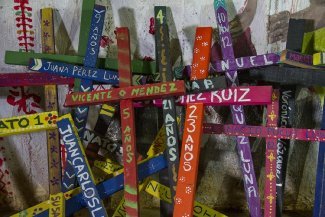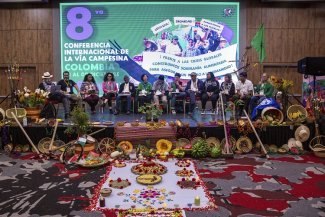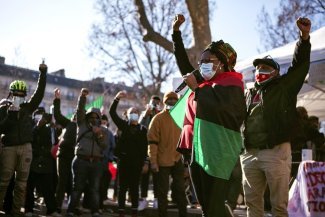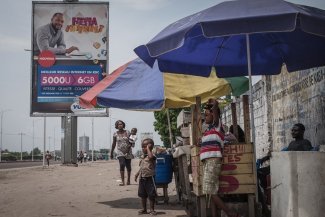A protest march in Mexico City on 26 April 2018 about the disappearance of 43 students from Guerrero state, a case that has had repercussions beyond the borders of this American country.
José Ángel Alvarado was talking to his cousin Nitza Paola outside the home of his in-laws in the town of Buenaventura, in the northern state of Chihuahua, Mexico, when they were detained by a military command. That same night, more soldiers came and took away their niece, Rocío Irene, from her own home. This happened on 29 December 2009 and they have never been heard from since.
Three people from the same family have disappeared. They are amongst a total of 37,435 people recorded by the Mexican government as having disappeared between 2007 and April 2018. The authorities admit, however, that the figure could be much higher, taking into account the many cases that are not reported, and those that have happened since April.
The Mexican government is facing trial before the Inter-American Court of Human Rights over the case of José Ángel, Nitza Paola and Rocío Irene. It is the first time since the so-called ‘Dirty War’ in the 1970s (when hundreds of Mexicans involved in the guerrilla movement went missing) that Mexico has found itself in the dock. This time it is in the context of the war against drug trafficking, Alejandra Nuño tells Equal Times. It was she, on behalf of the Chihuahua Women’s Human Rights Commission, who took the case to the Inter-American rights protection system.
It is not unusual for several members of the same family to disappear, either after being apprehended by state security forces, or taken away by individuals, generally with the complicity of corrupt agents from the security forces, either police or military.
Several of José’s family members are included in the statistics. He now lives in Mexico City, where he had to take refuge after receiving repeated death threats for demanding justice for his two brothers, a cousin and two people who worked closely with those who have disappeared at the hands of the mafia in Guerrero state – one of the poorest state’s in the country.
They are all residents of the town of Chilapa, who found themselves in the wrong place at the wrong time. Nobody knows for certain why they were taken by a command of delinquents belonging to one of the mafia gangs fighting for control of the area – a constant battle that has made the town the third most violent in the country according to a study by the organisation Citizens’ Council for Public Security and Criminal Justice. Chilapa is, for all intents and purposes, the gateway for the opium gum produced in the mountains around Guerrero.
After the incident, thanks to the GPS in the truck they were travelling in, that was also used to transport the command that kidnapped them, the Diaz Navarro family found out where their relatives were, but the police did not want to go rescue them “for fear” that it could trigger a shootout, and that many would die. That was the argument put forward by the authorities, José tells Equal Times.
Sadly this is not an isolated case. Two weeks ago a military command executed a group of suspected kidnappers in another state, and two months earlier 43 students disappeared from a village called Ayotzinapa, in Guerrero state. This last tragic event had international repercussions. The investigation carried out by the Mexican government was examined and subsequently discredited by a special group created by the Mexican authorities themselves, with the support of the Inter-American Commission on Human Rights.
The whereabouts of the 43 Ayotzinapa students are still unknown and the victims’ families reject the official version that a group of drug traffickers burnt the young people and threw their remains in a river.
Like all the families of the disappeared, they are demanding to see the 43 alive.
The whole of Mexico is like an unmarked grave
Some of the 37,000-plus missing people could be amongst the bodies that have been unearthed from the 1,307 unmarked graves recorded by the institution responsible for defending and protecting human rights in Mexico, the CNDH (National Commission for Human Rights).
Thanks particularly to the work of the groups of mothers and families of the disappeared, 3,926 bodies have been found in those graves. The last grave was found less than a month ago in the state of Veracruz, and it had 166 skulls in it.
The situation regarding the disappeared in Mexico is so serious that it has had to pass a law on the forced disappearance of persons; it was also necessary to set up a register of missing people and a National System for the Search of Disappeared Persons.
The head of the Government Secretariat (equivalent to the Ministry of the Interior in other countries), Manuel Navarrete Prida, has reported that by cross-checking the information held by different instances of the Mexican State, they have managed to match 4,500 of the remains found to the missing persons reports; of these, 340 have already been identified by their first and last names. Three hundred people had been missing for more than ten years.
To give an idea of the scale of the tragedy faced by thousands of Mexican and Central American families (many of the migrants travelling through Mexico on their way to the United States have disappeared) since 1980, the United Nations’ Working Group on the Enforced Disappearance of Persons has recorded a total of 56,363 cases relating to 112 states, that it has been in communication with, and that it has studied.
The cause: the use of the armed forces in the fight against drug trafficking
For Santiago Corcuera, who was a member of the Working Group (2004-2010) and its president from 2006 to 2009; and a member of the UN Committee on Enforced Disappearances, from 2013-2017, the root of this new wave of disappearances is to be found in the war launched in 2006 by former President Felipe Calderón against drug traffickers, sending out the Armed Forces to police the streets.
“By the end of the [President Vicente] Fox government, there were no more new cases of disappeared persons. His government had been very permissive with drug traffickers and no disappearances were reported. In 2008, so many cases were beginning to reach the Working Group that its members were becoming alarmed; they therefore asked for a visit in 2011. Mexico was reporting more cases than any other country,” recalls Corcuera.
All the UN rapporteurs, says Corcuera, and all the human rights organisations reached the conclusion that the mistake that was made was the decision to use the armed forces in public security tasks, provoking a spiral of violence. “It’s a tornado of mass destruction,” says the expert. All the political and historical responsibility “and one day, I hope, legal, lies with Calderón Hinojosa,” he insists.
Although it is hard to imagine, the statistics include children: a total of 547 small children under the age of four have disappeared; in the 5-9 age group 517 have disappeared, and for adolescents from 10 to 14 years the total is 1,861.
Of the total 37,435 missing persons, there are nearly three times as many men as women: 27,913 compared to 9,522.
Nuño believes there is no single cause for the disappearances in Mexico, because it can depend on age, profession, location, gender, nationality and other elements. “The disappearances of children do not conform to the same modus operandi as those of migrants, or professionals, students or women,” she says.
The CNDH, moreover, has criticised the national authorities’incorrect use of “concepts: the disappeared, gone astray, not located, absent, when referring to anyone whose whereabouts is not known,” which makes it difficult “to know how many incidents were due to suspected and/or actual criminal behaviour by agents of the state and/or private individuals and which are due to other circumstances”.
The recently-elected government of Mexico, led by the centre-left Andrés Manuel López Obrador (who will take up office on 1 December) has raised high expectations amongst the thousands of families of the disappeared. He ordered several meetings to be held in various states around the country, at which sometimes he himself and sometimes members of his team listened to the feelings and moving accusations of the current government’s failure to act. The future administration has promised to take action.
The principal cause attributed to the disappearances, namely the army’s participation in public security and the fight against drug trafficking, will not go away in the immediate future, however.
Despite it being one of his campaign promises, López Obrador has already announced that the armed forces will not withdraw from the streets because the police are not trained to confront organised crime. His team had to clarify later that the withdrawal of the military will happen after the police have been professionalised.
Nuño believes impunity is the key factor behind the continued disappearances. “If you make someone disappear in this country, there are no consequences.”











